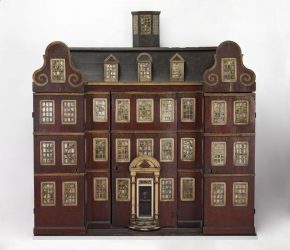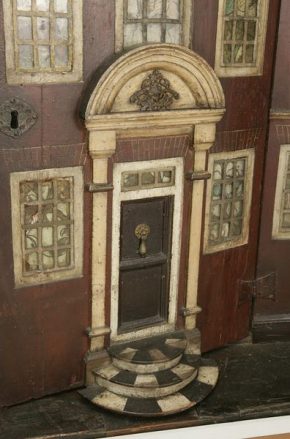The first house in the upcoming exhibition, Small Stories: at home in a dolls’ house will be the ‘Joy Wardrobe’, made in 1712. It’s a strange object to start with, because it is not in fact a dolls’ house at all.
The scale is right, and there are many little windows suggesting a wealth of rooms inside. There is even a knocker on the front door – surely there must be someone at home? But slowly pulling open the front, the central façade of the house swings back to reveal – nothing! It is empty inside, apart from a few pegs along the top of the back wall. Even though you know it’s a wardrobe, its emptiness is still a surprise every time. The doors on the two wings pull open to reveal shelves on the left and exquisitely painted drawer-fronts on the right. In fact, this is the only house in the exhibition that it would be possible to enter, to climb inside and pull the door shut behind you.

Our familiarity with wardrobes perhaps obscures how recent this piece of furniture is. In the early 18th century, clothes and linen were usually folded and stored flat in chests or ‘clothes presses’. These were generally low, with sliding shelves, and they could be beautiful and ornately decorated. Clothes, when hung at all, were hooked onto pegs.
See this Chippendale clothes press: http://collections.vam.ac.uk/item/O78977/clothes-press-chippendale-thomas-senior/ It also has space for hanging next to shelves and drawers.
The word ‘wardrobe’ in the 1710s referred not to a piece of furniture, but to a room or building where clothes were kept locked away. ‘Ward’ is an Old English word meaning ‘to keep guard, protect, preserve’. With its lockable doors, blind windows and imposing façade, the Joy Wardrobe would certainly have fulfilled this duty, even if it wasn’t called a wardrobe.
Representing a whole house, but at the scale of a clothes press, the Joy Wardrobe anticipates the widespread use of movable furniture for hanging clothes. It wasn’t just kings and courtiers who wanted to keep their fancy outfits in guarded buildings – but for the middling sort, the buildings didn’t need to be so big! It wasn’t until 1794 that designs for “wardrobes” as we know them appear in furniture catalogues.


